Increased frequency of antinuclear antibodies in elderly subjects: fact or artifact?

All claims expressed in this article are solely those of the authors and do not necessarily represent those of their affiliated organizations, or those of the publisher, the editors and the reviewers. Any product that may be evaluated in this article or claim that may be made by its manufacturer is not guaranteed or endorsed by the publisher.
Objectives: To evaluate the frequency of antinuclear antibodies (ANA) positive in elderly patients. Methodology: Ana test was evaluate in 1000 eldery patients with Indirect Immunofluorescence (IFI), which still represents the gold standard for the research of this type of autoantibodies. Results: We enrolled 1000 elderly patients ≥ 75 years (75-97y) from September 2019 to April 2020. In 29% of patients we found a positive ANA with a title ≥ 1:160. Conclusions: Our results confirm the data present in the literature. The reasons because in these patients there is an increase in the positivity of ANA are not yet known. Therefore, are these results the expression of a real increase in autoimmune rheumatic diseases in the elderly (predictive antibodies) due to the presence of other concomitant pathologies and the intake of drugs or may they depend on the greater sensitivity of the latest generation diagnostic methods? More comprehensive studies are needed to better understand this phenomenon.
PAGEPress has chosen to apply the Creative Commons Attribution NonCommercial 4.0 International License (CC BY-NC 4.0) to all manuscripts to be published.

 https://doi.org/10.4081/wpph.2020.9247
https://doi.org/10.4081/wpph.2020.9247




